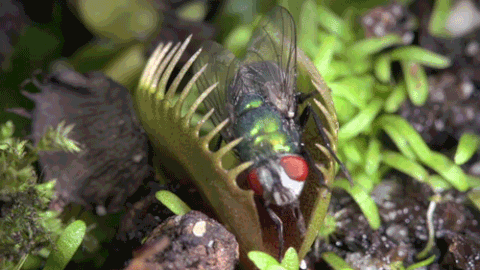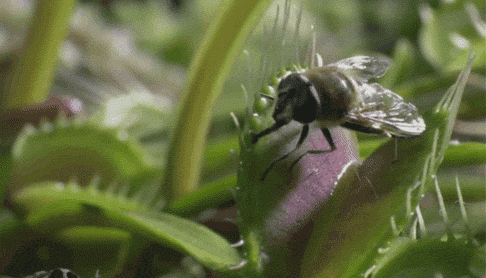
markgoddard/iStockPhoto
Posted on 11/12/2018 9:00:45 AM PST by ETL
PORTLAND, OREGON—Venus flytraps have a well-known way of dispatching their victims: They snare inquisitive insects that brush up against trigger hairs in their fly-trapping pods (above). But now, physicists have discovered that the triggering process may involve the release of a cascade of exotic chemicals similar to the whiff of ozone that tingles your nose after a lightning bolt.
To study this process, scientists used an electrical generator to ionize air into a “cold plasma,” which they then gently blew toward a flytrap in their lab.
Normally, the flytrap’s closure is caused by an electrical signal created when two or more trigger hairs are brushed. But highly reactive chemicals in the plasma stream such as hydrogen peroxide, nitric oxide, and ozone had the same effect, even when they were blown at the pods too gently to trigger them by motion, they reported here last week at the annual Gaseous Electronics Conference.
It’s a useful finding because the types of reactive oxygen and nitrogen molecules in cold plasmas play a major role in biological processes, including cell signaling. But normally, such processes have to be studied through complex analyses of cell cultures. With the Venus flytrap, they can be observed directly, when the pods snap shut.
Understanding such processes, the scientists say, could help biomedical researchers and aerospace engineers create a new generation of “intelligent materials” that can use similar signaling processes to change shape as needed, much as the Venus flytrap reflexively snaps shut when it senses its prey. It’s an open and shut case for new research, including a more detailed examination of exactly how the various parts of the plant know how to spring shut at just the right moment.








Say what??????.................



When an insect or spider crawling along the leaves contacts a hair, the trap prepares to close, snapping shut only if another contact occurs within approximately twenty seconds of the first strike. Triggers may occur if one-tenth of the insect is within contact.[4] The requirement of redundant triggering in this mechanism serves as a safeguard against wasting energy by trapping objects with no nutritional value, and the plant will only begin digestion after five more stimuli to ensure it has caught a live bug worthy of consumption.
Dionaea is a monotypic genus closely related to the waterwheel plant (Aldrovanda vesiculosa) and sundews (Drosera), all of which belong to the family Droseraceae.
Prey selectivity
Most carnivorous plants selectively feed on specific prey. This selection is due to the available prey and the type of trap used by the organism. With the Venus flytrap, prey is limited to beetles, spiders and other crawling arthropods. In fact, the Dionaea diet is 33% ants, 30% spiders, 10% beetles, and 10% grasshoppers, with fewer than 5% flying insects.[15]
Given that Dionaea evolved from an ancestral form of Drosera (carnivorous plants that use a sticky trap instead of a snap trap) the reason for this evolutionary branching becomes clear. Drosera consume smaller, aerial insects, whereas Dionaea consume larger terrestrial bugs. Dionaea are able to extract more nutrients from these larger bugs. This gives Dionaea an evolutionary advantage over their ancestral sticky trap form.[16]
Mechanism of trapping
The Venus flytrap is one of a very small group of plants capable of rapid movement, such as Mimosa pudica, the Telegraph plant, sundews and bladderworts.
The mechanism by which the trap snaps shut involves a complex interaction between elasticity, turgor and growth. The trap only shuts when there have been two stimulations of the trigger hairs; this is to avoid inadvertent triggering of the mechanism by dust and other wind-borne debris. In the open, untripped state, the lobes are convex (bent outwards), but in the closed state, the lobes are concave (forming a cavity). It is the rapid flipping of this bistable state that closes the trap,[11] but the mechanism by which this occurs is still poorly understood. When the trigger hairs are stimulated, an action potential (mostly involving calcium ions—see calcium in biology) is generated, which propagates across the lobes and stimulates cells in the lobes and in the midrib between them.[17]
It is hypothesized that there is a threshold of ion buildup for the Venus flytrap to react to stimulation.[18] After closing, the flytrap counts additional stimulations of the trigger hairs, to five total, to start the production of digesting enzymes.[19] The acid growth theory states that individual cells in the outer layers of the lobes and midrib rapidly move 1H+ (hydrogen ions) into their cell walls, lowering the pH and loosening the extracellular components, which allows them to swell rapidly by osmosis, thus elongating and changing the shape of the trap lobe.
Alternatively, cells in the inner layers of the lobes and midrib may rapidly secrete other ions, allowing water to follow by osmosis, and the cells to collapse. Both of these mechanisms may play a role and have some experimental evidence to support them.[20][21] Flytraps show a clear example of memory in plants, the plant knows if its hair has been touched, and remembers that for a few seconds. The plant then recalls that accident if a second touch happens during that time frame, and closes.[22]
Digestion
If the prey is unable to escape, it will continue to stimulate the inner surface of the lobes, and this causes a further growth response that forces the edges of the lobes together, eventually sealing the trap hermetically and forming a “stomach” in which digestion occurs. Release of the digestive enzymes is controlled by the hormone jasmonic acid, the same hormone that triggers the release of toxins as an anti-herbivore defense mechanism in non-carnivorous plants. (See Evolution below)[19][23] Once the digestive glands in the leaf lobes have been activated, digestion is catalysed by hydrolase enzymes secreted by the glands.
Oxidative protein modification is likely to be a pre-digestive mechanism used by Dionaea muscipula. Aqueous leaf extracts have been found to contain quinones such as the naphthoquinone plumbagin that couples to different NADH-dependent diaphorases to produce superoxide and hydrogen peroxide upon autoxidation.[24] Such oxidative modification could rupture animal cell membranes. Plumbagin is known to induce apoptosis, associated with the regulation of the Bcl-2 family of proteins.[25]
When the Dionaea extracts were pre-incubated with diaphorases and NADH in the presence of serum albumin (SA), subsequent tryptic digestion of SA was facilitated.[24] Since the secretory glands of Droseraceae contain proteases and possibly other degradative enzymes, it may be that the presence of oxygen-activating redox cofactors function as extracellular pre-digestive oxidants to render membrane-bound proteins of the prey (insects) more susceptible to proteolytic attacks.[24]
Digestion takes about ten days, after which the prey is reduced to a husk of chitin. The trap then reopens, and is ready for reuse.[26]
Feed me Seymour!
I don't have audio at the moment.
This one was always my favorite flytrap.




Misleading and confusing article.
That gong he used caused grief.
These things must give off some kind of pheromone that attracts and disorients the biggest horseflies I’ve ever seen.
My daughter gave me one a few years ago and we had flies from six counties trying to get into that thing.
They would fly like they were drunk and seemed to have absolutely no will to escape capture.
I don’t remember it actually catching one before we got rid of it.
7
God is a genius.
” annual Gaseous Electronics Conference.”
Who knew?
I remember being quite fascinated with these as a kid, they’re native to the inland areas near beaches my family went to for summer vacations, the lower coastal plain of NC and upper coastal plain of SC. There’s a big problem with poaching them so they’re protected, but propagation from seeds is not forbidden so there’s a good business growing them potted for sale. They’ve also been introduced and successfully propagated in the wild outside of NC and SC, in northern FL and western WA. I have no pity for the insects that they eat, but they do occasionally get tiny tree frogs too, which I don’t like. Call me speciesist, lol.
You didn’t go??
Everyone here went!
Disclaimer: Opinions posted on Free Republic are those of the individual posters and do not necessarily represent the opinion of Free Republic or its management. All materials posted herein are protected by copyright law and the exemption for fair use of copyrighted works.